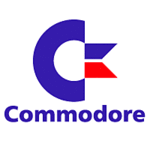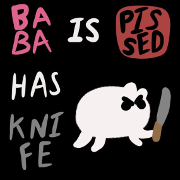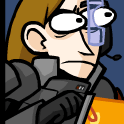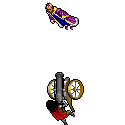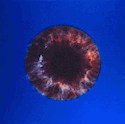|
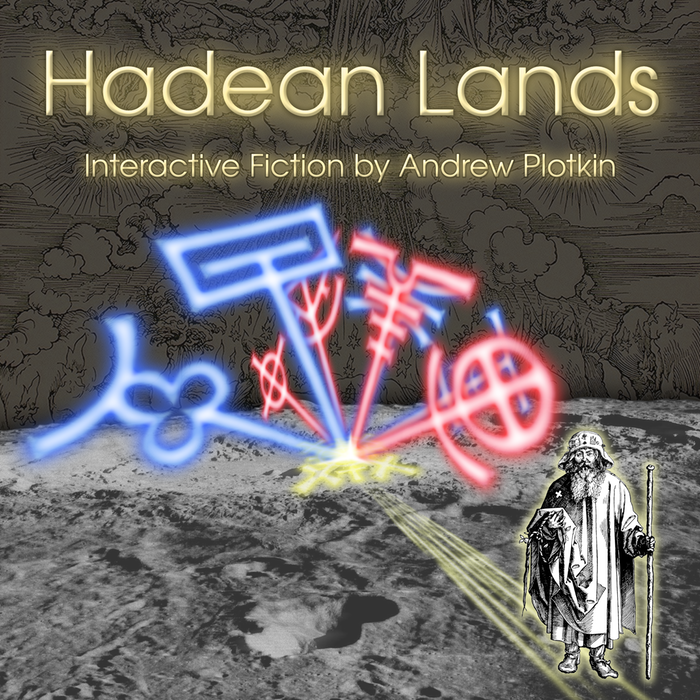 Are we really going to do the Q&A style introduction right off the bat? We sure are! This is a parser-based interactive fiction game, it'll get us into the habit of call-and-response. Fine, fine. What is Hadean Lands? It's interactive fiction by Andrew Plotkin, like it says. We're a journeyman alchemist aboard His Majesty's Marcher The Unanswerable Retort and something very bad has just happened. Our task is first to survive and then to sort out what to do about it. What is a "marcher"? Apparently it's some kind of alchemical starship, according to the marketing materials. That's kind of a lies-to-children answer, though. We'll be seeing much more of the marcher in-game. OK, anyone reading this probably already knows the answer to these questions, but just in case: what is "interactive fiction", who is "Andrew Plotkin", and what did you mean by "parser-based"? These days, interactive fiction (IF for short) encompasses a huge swathe of disparate stuff these days, but it generally means a mostly-text-based or text-focused game that the user interacts with by textual or text-like means. "Parser-based" IF generally descends in some way from Colossal Cave and Zork, and those by way of the old SHRDLU Blocks World system; a world of >GET LAMP and >KILL TROLL WITH SWORD and >ASK GUARD ABOUT SCHEDULE and >INTONE THE LESSER PHLOGISTICAL SATURATION. They are what your average goon would think of as "text adventures", even when they aren't necessarily adventures, or entirely text. (The comparison is generally to "choice-based" IF, which invokes the old Choose Your Own Adventure books or the modern Choice of Games line.) In recent years, "interactive fiction" has grown diverse enough and incorporates enough independent traditions that we can include things like visual novels within it without having to hedge about how it's an independent tradition tha thappens to look a whole lot like choice-based IF. Andrew "Zarf" Plotkin has been a major figure in what I'll call the Zork tradition from the mid-1990s through the present day, both as an author (So Far, Spider & Web, The Dreamhold) and as a technologist. What makes Hadean Lands interesting, then? Its history is kind of interesting. It started out as a Kickstarter—the first IF-related kickstarter I'm aware of—hit its fundraising goal on the first day, ended up raising many times its initial goal, then dragged on interminably with a trickle of secondary releases before finally coming out full-formed in 2014. It started life as an iOS game, despite being based on old PC technologies; those were refined over the next few years and it ended up on Steam in 2016. So, basically Broken Age, then? It's different from Broken Age in that (1) the amounts of money were much smaller; (2) the secondary releases were four completely different games, all for iOS (the Kickstarter itself was "Interactive Fiction for the iPhone"); and (3) this kickstarter happened over a year before Broken Age made Kickstarting video games an omnipresent cultural force. What makes Hadean Lands interesting as a game as opposed to as a forerunner of Internet drama? It's a very large game, with a big map, a complicated alchemical ritual system, and a ton of independent and sometimes mutually contradictory goals. Many complicated, multi-stage actions will need to be executed dozens of times. The neat part—especially if you've spent a lot of time playing text games—is that the command parser has an insanely sophisticated goal-seeking AI built into it. If it knows that you've already proven how to do something, you can do it with a single command. I once had a > GO WEST command translate into dozens of subgoals and probably thousands of commands. Reviews of the game at the time tended to talk about how the other major figures in parser IF were very impressed by this system and swore to never attempt anything like it themselves before fleeing in terror. This means that Hadean Lands is likely to continue to hold its throne as the most sophisticated Zork-like game that has ever or will ever be made. Oh, that reminds me. This is a Manxome Bromide LP. Are there going to be tech posts? Not really. Once things get off the ground I'll dedicate a brief post to the technologies involved in making the game run on the devices it runs on, but the mechanics of how the game works will be revealed through play. Watching a sophisticated system work out its implications is a large part of the joy of Plotkin's IF generally, and Hadean Lands is no exception. Will there be audience participation? What's the update schedule going to look like? I'm aiming for at least weekly, but it will get much faster when there's a lot of text and very little strategic decision-making. There is a lot of text in the game, and as the game proceeds the focus will shift from immediate problem solving to more long-term planning. I'll be running faster through the earliest parts, where the mechanics are introduced, and then slow down once our options expand. Any important votes will be held open for at least three days. I'll also be drawing attention to particular aspects of the writing we've seen either as discussion topics, invitations to rampant speculation, or just to make sure that certain details don't get lost in the flood. Let's begin!
ManxomeBromide fucked around with this message at 04:04 on Jul 15, 2018 |
|
|
|

|
| # ? May 5, 2024 00:47 |
|
Now that our journey has completed, our alchemical journal is also complete. Here is all the data that we can get out of the Alchemy Journal Window. The Alchemical Journal of Ensign J. Forsyth MAP  Click here for the full 1000x960 image RITUALS
FORMULAE
FACTS
ManxomeBromide fucked around with this message at 04:10 on Jul 17, 2018 |
|
|
|
Part 1: Ensign Forsyth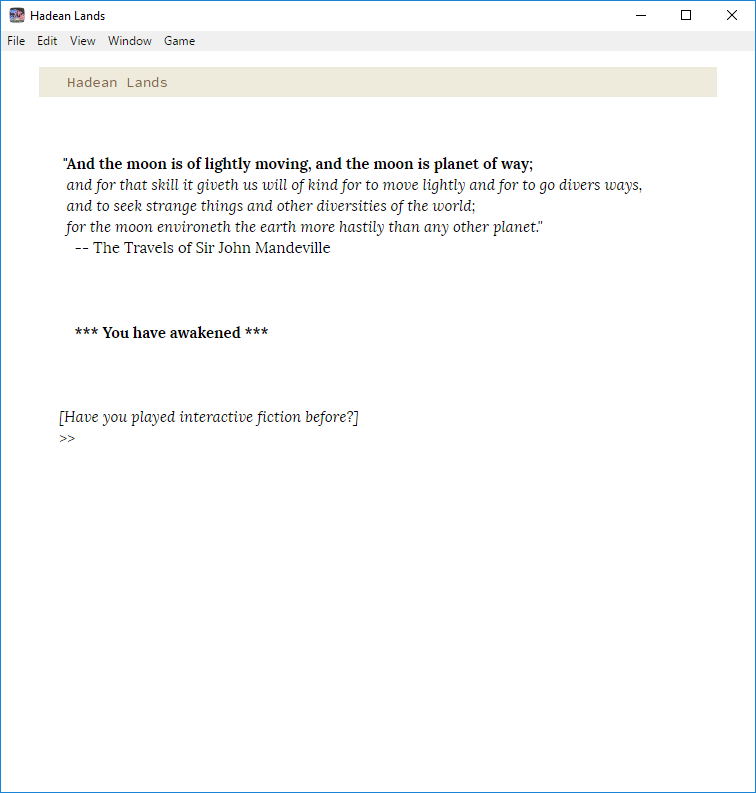 We sure have. quote:>>YES That option just provides a new window with an image of a basic primer on how parser games work, not specific to Hadean Lands. This isn't our first rodeo. We'll be fine. Presumably. The game then opens properly: quote:You smell copal incense, machine oil, rosemary, alcohol, and blood. Creaking, bending steel beams... no, that's not an odor. Why did you think the bulkheads were crumpling in on you? What would that even smell like? Plotkin identifies it as "Overdue Interactive Fiction" because of how long it took to release this after its Kickstarter completed. He didn't technically promise a release date, though, so who's to tell for sure? But this does not concern young Ensign Forsyth. Let's get a handle on our surroundings. quote:>X CRYSTAL This hasn't been covered by our basic alchemical training, I don't think. Let's see what we have to hand. quote:>X HEAP We've just learned an alchemical ritual, and been given a thing to practice it on. Well, we're locked in this room by a shattering of reality itself. We might as well polish the instruments. This isn't a game with XP, really, but at least we'll learn something. The rest of the objects seem pretty self-explanatory, but what's with the oils? quote:>X PEPPERMINT That's probably what it means about "prepare an atmosphere of fiery principles." I have no idea which of these does that, though. Let's start with the peppermint, since it was listed first. quote:>PUT BRASS PIN IN BOUND Oh, do we have to seal it directly? quote:>SEAL BOUND Wait, peppermint is icy? Abort! Abort! quote:>CANCEL RITUAL I've been hiding one of our resources here. Available from the Game Menu is an "Alchemy Journal", and it records basically everything we learn in exhaustive detail. We in fact, being an journeyman alchemist already, already know some facts as it is. Here's the one we actually need right now: 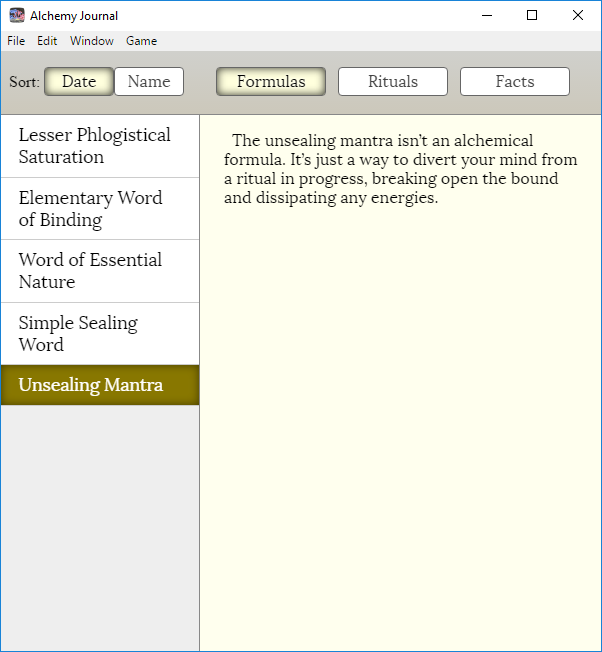 So let's speak the unsealing mantra and do the ritual right this time, which presumably means ginger instead of peppermint. quote:>SPEAK UNSEALING MANTRA Success! quote:>X SYMBOL Gained:  Not gained: Any way of dealing with the fact that our lab door appears to lead to the Moon. Next: We prove this isn't in fact a one-room game. To Do And Notice: Compare our attempt to execute the ritual in an incorrect environment with our successful ritual. What was different in the environment? In our mental state? ManxomeBromide fucked around with this message at 04:21 on Jul 16, 2018 |
|
|
|
Well this should be interesting. Plotkin has a fairly dry, terse writing style that, perhaps unsurprisingly, lends itself well to IF.
|
|
|
|
It's one of the most brilliant IF games ever, IMO. Really satisfying magic system and puzzles, cool if sparse worldbuilding, and holy hell, the automation tech is amazing (and super needed for the way the game plays).
|
|
|
|
Oh man, a knowledgeable LP of this game! Score! I've been going back and forth on purchasing this game for years, as I like IF and weird sci-fi, but I'm also bad at the kind of puzzles this game wants you to solve. I think I always knew in the back of my mind that when I bought it I'd play through the first room and go "too complicated" and never pick it up again, so! Looking forward to more of this!
|
|
|
|
Meanwhile, I'm probably going to get Hadean Lands next time I'm at a loss for a game to play on my laptop, so I will probably bow out of this after the second update or so. But I'm glad you're running it!
|
|
|
|
Part 2: There and Back Again Welcome back! Last time we cleaned some brass calipers despite being trapped in some kind of horrific reality fracture. Today we will actually escape the lab. But first, a confession. You don't actually have to use trial and error to work out which impet of essential oil to open for the tarnish cleansing ritual. The Alchemy Journal doesn't start empty, and it can also be interrogated with commands. Remember how when we found the instructions we were invited to >RECALL various facts? quote:>RECALL This is all either useless fluff or things we've seen before. This, on the other hand, is very much not: quote:>RECALL A LECTURE ON AROMAS Okay. That dealt with, let's actually try to get ourselves out of here. Let's poke around the lab more carefully. quote:>LOOK Hmmm. If a brass pin will clean brass calipers, will a steel bolt...? quote:>PUT BOLT IN BOUND quote:>RECALL RITUALS quote:>DOWN quote:>X FLASK Poor students. Just treated like glorified janitorial staff. Still, it might come in handy. quote:>GET IT Hm. Well, let's see where we can go before bashing our heads against new barriers, even if we've got a pretty good idea of what to do about it. Let's go through that doorway. Unfortunately for us, that's not a dark doorway because the lights aren't on, but because it leads into an abyss of utter nonexistence: quote:>S What has just happened is that we have just learned the >RESTART verb. In most parser games, RESTART is a complete reset of the game state, undong all your progress. In Hadean Lands, it represents traveling to this location or several others like it throughout the game map. This resets the game world but not our progress. Our Alchemy Journal is untouched. We still know everything we've ever found out, and that has two important consequences. First, it means that the game engine knows which puzzles we've solved and will solve them for us to get them out of our way if needed: quote:>DOWN Second, if we ever end up learning new rituals or facts by experimenting with things we destroy, we need not worry because those facts will remain with us. We are free to experiment and don't need to bother with savescumming unless we're being exceptionally destructively systematic about something. Anyway, now that we've done that, let's get back to where we were and actually check out that other corroded hatch. quote:>X HATCH Time to turn our bolt into a miraculous alchemical rust-cleaning machine again. We can't just make it happen with >UP though, because we have never gotten this particular hatch open. But we have performed this ritual before, so we can do that and its prerequisites in a single command: quote:>PERFORM BASIC RUST CLEANSING Automatically fulfilled prerequisites can include getting to the appropriate lab. If you need special lab equipment to do a ritual (in this case, we need the "ritual bound" that holds the bolt), any prerequisites for reaching that equipment will be folded into the command resolution AI. Oh yeah, also, before we go... quote:>PERFORM BASIC TARNISH CLEANSING Imagine if we managed to singlehandedly resolve a massive crisis that had crippled the entire marcher, and didn't clean those calipers like Sarge asked. We'd never hear the end of it. Punishment details for months on end. Back once again to that rusted hatch and... quote:>TOUCH BOLT TO HATCH Well then. Time to start exploring the rest of this. Hopefully we can make our way into a lab that will let us get out into the marcher proper, or that has the equipment or reference material we need to learn how to open really stuck doors. quote:>W Oh, okay, or someone could have left those instructions for us rotting in a basement corner. That works too. Let's finish exploring this crawlspace. quote:>N Neat. Not immediately useful, but neat. We've only got one unexplored, unblocked passage left to us: the hatch that led down out of the crawlspace bend. "Wait," I hear you ask. "Down? Aren't we in the basement crawlspaces already?" Well, yes, but: quote:Herbarium Nook "That's a marcher for you," our hero thinks. It's worth noting that the marketing material doesn't describe The Unanswerable Retort as a "marcher." Only people in-universe seem to do that. It calls the Retort an alchemical starship. Perhaps these reality fractures are less completely out of left field than we would consider, out here. In other news, hey, check it out, a pine cone! Just we we need for that Redoubled Rust Cleansing ritual! What are those orange threads, though? quote:>X THREADS That's kind of a more venal sort of irregularity than the reality fractures, but in some sense that—and the giant brass combination lock—are even bigger mysteries than the cosmic disaster. Next Time: We actually make it into the Mechanica and Chymica Labs. From Last Time: When we were fumbling a ritual, the actions we took and the formulae we pronounced were described as inert or even recalcitrant. Furthermore, when we sealed the ritual bound, the colors were different. Bonus Trivia: Several elements of this universe are things that exist in our world but ended up being given different names. Orange zafranum is one of those things. Lubanja is another. What are they? Warning: Don't just google these directly, because all you will find are spoilerrific walkthroughs for this game. I have a very good idea of what orange zafranum is, and a plausible but not very firm hypothesis about Lubanja. So let's hear it: what are these substances, and why did they get these names? ManxomeBromide fucked around with this message at 04:23 on Jul 16, 2018 |
|
|
|
Orange zafranum is presumably saffron, from the "thread"-like description and color. The names are also similar. I have no idea what Lubanja could be, but perhaps it's a cognate in some language I don't know. Spanish, maybe? I bet we could deal with that brass lock if we had some way to cause oxidation. A dephlogistinating invocation, say. We might also need to change the "ingredients" (the fiery atmosphere / resinous note). To guess wildly, peppermint, being cold, opposes the hot ginger, so while ginger allows us to reverse oxidation, peppermint would allow us to cause it. It's not clear how the resinous note works or what it impacts, but it modulates the ginger scent somehow. Perhaps scent overall serves as a kind of "targeting" for the ritual?
|
|
|
|
quote:You have learned one ritual: I see that the wizard school is next to a pub.
|
|
|
|
Lubanja I would like to assume is some kind of turpentine, or more likely, Camphor.
|
|
|
|
Rigged Death Trap posted:Lubanja I would like to assume is some kind of turpentine, or more likely, Camphor. I theorise it's gum turpentine, which was carried on 16th century ships as a rub-on painkiller and a (harsh) treatment for intestinal parasites. It may have uses in this regard if the setting is going to be Alchemical Starship Troopers (which would be hilarious). Am I right in thinking we looped around the ship there? Exited through the bottom and appeared at the top? This seems to be normal for Marchers from the dialogue; we are bounded in a nutshell as we traverse infinite space. EDIT: It occurs to me that a lot of historical alchemy had to do with associating heavenly bodies with chemical elements. Presumably that will be how this spacecraft navigates. I'm really keen to see where they go with this.
|
|
|
|
TooMuchAbstraction posted:Orange zafranum is presumably saffron, from the "thread"-like description and color. The names are also similar.
|
|
|
|
As someone who replays this game every year or so and has been inspired by it to learn Inform 7 and make a game heavily inspired by it and my experience working as an experimental physicist, I'm both pleased it's getting more exposure through this LP and a little chagrined that I didn't get there first. Good game! I'm also looking forward to the discussion of what's actually going on here!
|
|
|
|
Wow. This seems extremely interesting. It looks like the Resets are acknowledged in-universe, too?
|
|
|
|
Safranum is the Latin name for saffron, which itself is derived from a similar Persian form, so I guess it's just supposed to be an alternate word from the same etymology. And the name and description are a shoe-in (though saffron is often described as yellow or golden I've always thought orange is a more appropriate comparison - it's similar in colour to many orange flowers) p.s. this game looks amazing and I can appreciate any work of fiction which has me looking up etymologies for fun.
|
|
|
|
Part 3: Your Friend, Phlogiston Last time, we wandered into the endless void, found two doors we couldn't open, what we needed to open one of them, and reset the universe. bibliosabreur posted:It looks like the Resets are acknowledged in-universe, too? They are, and as we've seen, it's possible to cause a reset purely by acting within the game universe. The traditional, out-of-universe reset—which also resets your alchemy journal and sets the solver code to believe you have accomplished nothing—has been renamed to >RESTART COMPLETELY. As for the door we don't yet obviously know how to open... TooMuchAbstraction posted:I bet we could deal with that brass lock if we had some way to cause oxidation. A dephlogistinating invocation, say. We might also need to change the "ingredients" (the fiery atmosphere / resinous note). To guess wildly, peppermint, being cold, opposes the hot ginger, so while ginger allows us to reverse oxidation, peppermint would allow us to cause it. It's not clear how the resinous note works or what it impacts, but it modulates the ginger scent somehow. Perhaps scent overall serves as a kind of "targeting" for the ritual? The atmosphere is the only real thing we can reverse here. Resin seems to have a strength (given the pine cone) but we don't know of any polarity. And formulae can't be spoken backwards. Let's head back to the lab and see... quote:>OPEN PEPPERMINT No luck. I think the reason for this is that we'd need some kind of counter-formula for the Phlogistical Saturation. Why is that? To answer that, let's start with a simple explanation by a Real Scientist!  (Click image for video) (Also, in an odd coincidence, this Real Scientist is also the guy who ran the annual Interactive Fiction competition for the first decade or so of its existence. I have my ears in the IF world but that is not how I ran into this. The world is a pretty small place when you're a certain kind of Giant Nerd, I guess.) Anyway, in actual Earthly chemistry, what is rust? It's oxidized iron. It's iron that has spent some time burning really slowly. Which is thus to say, while we think of phlogiston as being released when something burns, it is also released, more slowly, when metal corrodes. So phlogistical saturation is shoving all the phlogiston back into it, which restores its more traditionally metallic nature. It's a little strange to think of metal as becoming more elementally metallic when you mix more of something into it, but the ways of matter are abstruse and strange. In any case, we don't really have any leads on that brass lock yet, so let's do the redoubled saturation ritual with the bolt and see if that will fix the second hatch. quote:>SPEAK UNSEALING I know that it's really just applying a verb to a glorified inventory item, but >INTONE THE LESSER PHLOGISTICAL SATURATION doesn't really get old. quote:>X BOLT Back to that hatch, and, hopefully, into the Mechanica Lab: quote:>TOUCH BOLT TO HATCH Man, this place is falling apart and hey wait a minute is that a rod of solid platinum over there quote:>X PLATINUM This may be the least interest I've ever seen an adventurer show in a rod of solid platinum. I suppose that as an alchemist we think of platinum less as a valuable metal and more as something to build catalytic converters out of. I also suppose it's more urgent at the moment to assess the damage: quote:>X MOLD Strange indeed. Well, we've got a door to the west... quote:>W This reference to a "key of H" implies that the Empire that commissioned the Retort uses the German names for musical keys. H is what we would call B, and if we encounter something in the key of B that is what we would call B flat. (For years, I thought this was just a thing that Douglas Hofstadter made up to make some conceits work in Gödel, Escher, Bach, but Wikipedia backs it up.) quote:>X BOUND Yeah, the opening scenes in Hadean Lands really are just a chain of locked doors with keys next to them. Don't worry, we'll be expanding our scope soon enough. We need platinum wire to produce a catalytic environment. Maybe there's some stored in the wire drawer next door. quote:>X WIRE-DRAWER Oh. OK. How about the wheel, then? quote:>X WHEEL Neat. We don't need alloys right now, though, just platinum wire. quote:>GET PLATINUM ROD Join the Navy, they said. See the Cosmos. Turns out it's still 90% hard manual labor. But enough hard manual labor. There is science to do. Back to the materials store... quote:>PUT WIRE ON BOUND Catalytic converter: check. quote:>PUT PIN IN BOUND Green, this time. It was orange when we opened the ginger, and blue-white with the peppermint. These reflect the overall environment or conditions in which the ritual takes place. Green must signify catalytic. quote:>RECITE THE CATEGORICAL IMPERATIVE ... what, did you think that thread title was just for show? Also, this may be the most impossible-to-film sentence I've ever seen in an IF, and given that my last IF LP was of a game written entirely in a conlang with no glossary, that's really saying something. quote:>POUR LUBANJA ON PIN I am fairly certain that Lubanja is gum spirits of turpentine, which several readers volunteered on their own. While writing up this update, someone outside the thread also found the etymology—this is an abbreviation of the Arabic luban jawi, or "Java Frankincense." Luban at the time would have meant any fragrant tree resin, which gum turpentine certainly involved. Researching this also turned up an alarming number of websites where people are wondering whether turpentine is safe to drink, and warnings that it is not. Most modern turpentines haven't been trees for hundreds of millions of years, and it seems that several people a year end up killing themselves by drinking paint thinner while thinking it's some kind of traditional medicine. That got unusually morbid. Sorry about that. Where were we? Oh yes. quote:>INTONE THE LESSER PHLOGISTICAL SATURATION Sounds good. Let's go back and apply it to that horribly corroded cabinet. quote:>TOUCH PIN TO CABINET We don't recognize the handwriting, but we do know a JA—Lieutenant Jana Anderes was looking suspicious while frozen in crystal and holding a reagent jar. If it's her, though, you'd think we'd know what her writing looks like. Also, that looks like it should get us past one locked door. What's this other sheet? quote:>READ RUST-STAINED SHEET And that's the key for the other. More importantly, that's the first ritual we've learned that doesn't involve phlogisticating something. Progress. There was both mustard seed and a dead mushroom in the Herbarium Nook. We snag those on the way to the brass lock at the end of the crawlspace. quote:Chem Lab Crawlspace I have a better idea.  quote:>SET DIAL TO MARS See how much better an idea that was? Now we can make it into the Chymic Lab proper. quote:>OPEN HATCH Oh hey, more instructions to follow, and, more importantly: a flask of saline, our final reagent. (Note also "muriatic acid". That's an archaic name but not a fictional one: it's an old name for hydrochloric acid. It's sufficiently respectable that at the time of this writing, Wikipedia will automatically redirect from "Muriatic acid" to the HCl page.) quote:>READ SIGN Oh, in fact, we weren't ready for our ritual; the sealing word we knew doesn't work for chymical rituals. That's why you read the instructions!  quote:>READ FOLDED SHEET Well, that's two new formulae, at least. That calcinate of copper isn't helpful to us yet at all, though; what good is a ritual that only produces a product you must immediately throw away? If we >RECALL it won't even show up in our rituals—it's filed with the trivia under "facts". Next Time: We actually finish the tutorial area. ManxomeBromide fucked around with this message at 04:24 on Jul 16, 2018 |
|
|
|
The Alchemy Journal is now in the second post in this thread. It will be more useful later, but it's already decently-sized here at the end of the tutorial.
|
|
|
|
There's definitely something weird going on with the passage of time! As for "recite the categorical imperative", they...surely don't mean "act as if the maxims of your action were to become through your will a universal law of nature"? Now for what little I remember of chemistry. Platinum has to do with catalyzing redox reactions, and the phlogistical reactions seem to do with reversing oxidation; so far so good. Heaven knows what quickcopper or orichalcum is, and why HCl seems to break it down into an unstable copper salt.
|
|
|
|
bibliosabreur posted:Heaven knows what quickcopper or orichalcum is, and why HCl seems to break it down into an unstable copper salt. Orichalcum is a real thing. "a yellow metal prized in ancient times, probably a form of brass or a similar alloy."
|
|
|
|
Quicksilver is mercury; maybe quickcopper is gallium? A "lesser" liquid metal (as copper is a "lesser" metal to silver) because it has a higher melting temperature. Could be useful if we need to degrade some aluminum though. I guess it might be something like bismuth.
|
|
|
|
Orichalcum may sometimes be used for brass, but that's not the sort of reaction one would expect from the interaction of brass and hydrochloric acid. I believe you can use HCl to clean brass relatively safely, in fact, and it's certainly not an unstable process. It does wear the brass down, but it doesn't produce the reaction described on the note. EDIT: Apparently mixing gallium and HCl can produce hydrogen? And bismuth oxide reacts with HCl in some manner I don't understand, but it's apparently an important chemical thing, but it's a powdery substance and not a liquid as "quickcopper" sort of implies. I think TooMuchAbstraction is on the right track with quickcopper being something like one of these things but I don't know enough about chemistry. Nakar fucked around with this message at 05:34 on Jun 8, 2018 |
|
|
|
TooMuchAbstraction posted:Quicksilver is mercury; maybe quickcopper is gallium? A "lesser" liquid metal (as copper is a "lesser" metal to silver) because it has a higher melting temperature. Could be useful if we need to degrade some aluminum though. Doubtful. Quickcopper is apparently just another name for orichalcum, which could be drat near anything given the setting.
|
|
|
|
ManxomeBromide posted:That calcinate of copper isn't helpful to us yet at all, though; what good is a ritual that only produces a product you must immediately throw away? I suspect that's what the Word of Entension is for -- make it, then put it in stasis until you need an exploding test tube (or whatever sort of instability it evinces).
|
|
|
|
I note an "impet", while clearly some kind of aerosol volatiser here, has the more obvious meaning of a small imp or little devil in folklore. Since there's no obvious reason to describe a bottle AS a demon (as opposed to lurking in one), I'm imagining the impets as having some sort of carved devil motif, like Victorian skull-shaped poison bottles that could be easily identified by touch in poor light.
|
|
|
|
I'm sorry to say I'm going to have to stop reading this LP for now. Because you convinced me to buy the game and I don't want to spoil it for myself. So, uh, good work!
|
|
|
|
This is a fascinating concept and I'm eagerly waiting to see what comes next. Some speculation about the setting below. Following off the back of the earlier discussion about etymology, the way the vessel the protagonist is on is described as a marcher is interesting. In addition to the more modern meaning of military marching, march is also an old Germanic word for a borderland between two areas (like, for example, the Welsh Marches in the UK), and to say something "marches with" can also mean it has a common border. There are a couple of other interesting observations so far that jump out. So far we've seen three things that would classify as "borders" - the fracture (which seems alien to the protagonist), the void (even moreso) and the "Hadean Land" (which was pretty clearly not, although it appeared in an unexpected place). So the protagonist is used to seeing alien landscapes in the context of the marcher, albeit not in that specific location. There's also the protagonist's comment about the herbarium - "Odd to reach it from the sub-basement; you usually come here through the upper laboratory floor. But that's a marcher for you." At first I thought this was just a comment on the fact that the protagonist had used the crawlspace to enter rather than coming through the front door, but the additional line implies something a bit more involved might be going on. It's interesting that (so far, at least) all the rituals that we've seen ManxomeBromide perform have had a pretty clear bordering (the platinum wire) or sealing (the two seals learned so far) component to them, although I don't believe we've seen use of alchemy to physically seal or lock something so far. Maybe that will come up? This seems to suggest that the way the marcher works is quite different to what we would think of as a spacecraft, and might also imply something about what's gone wrong.
|
|
|
|
Muriatic acid isn't outdated as a name, I have a bottle clearly labeled as such that was purchased this millennium. I don't know if it'll be relevant, but 'Hermetic Seal' would mean an airtight seal (just as it does in modern usage) but since it's a word or incantation of some sort, it could also be related to the symbol for quintessence (the 'Hermetic Seal of Light', which is a circle inscribed in a square inscribed in an equilateral triangle inscribed in a circle). Kangra fucked around with this message at 04:15 on Jun 9, 2018 |
|
|
|
idhrendur posted:I'm sorry to say I'm going to have to stop reading this LP for now. There is no better reason to retire from the thread. We'll still be here when you get back—or, failing that, in the archive.
|
|
|
|
Part 4: You Can't Spell "Alchemist" Without "Chemist" Last time, we made it into the Chymic Lab and read some instructions. Let's explore a little before we actually use the lab. quote:Chymic Lab The Thalassan land always puts me in mind of Titan, but of course Titan has a solid surface. Let's brew some fungicide. quote:>PUT SALINE IN RETORT Now, the instructions said to heat it to a slow simmer, so I suppose we'll need to wait a while... quote:>Z Perfect. Let's wrap this up before the saline bubbles off completely. quote:>INVOKE THE BINDING OF ANTIPATHY Convenient! Also notice that glassware is so ubiquitous we don't need to carry any around; we can just pluck it out of the undescribed environment as needed. That's a marcher for you, I guess. quote:>X FUNGICIDE Instant death! That's what I like to hear. Let's go put it to good use. quote:Mechanica Lab This whole "being haunted by the Sergeant" thing has been kind of a mixed bag, over all. Hey, that's the Chymic Lab Door over there. The one that led to a Thalassan land from the other side. What happens if we open it from this end? quote:>OPEN CHYMIC DOOR Nothing much. Though honestly, "nothing" is a pretty good result here. So, now what? At this point, we've left the tutorial area and have entered the first part of the main game. We won't, yet, have full run of the Marcher, but Ensign Forsyth actually does know this marcher pretty well. We can call up a complete graphical map, with labels, at any time. However, that map shows information we would normally not encounter as players until we get there, and that Forsyth would not know until reaching them in-game. So, I will be presenting the map in pieces as we explore regions more thoroughly. Our task now is to visit all the newly-reachable rooms and devour all the delicious knowledge that lurks within. This eastern lab is basically a square hallway with labs off every wall, and a hallway out to the rest of the marcher from the northwest corner. Let's loop around and see what we can find. Well. There's a discarded sheet right in front of us. Let's start with that. quote:>READ PAPER That gets us a new fact in our Alchemy Journal. quote:>RECALL GESTALT SHELF Sounds good. Now, if the crawlspaces work out, the lab we started the game in should be off the south wall to our east. quote:>EAST Just like the Chymic Lab door. Let's go check out Opticks. quote:>OPEN OAK Based on these descriptions, I think Erebian lands are worlds like Pluto, while Hadean Lands are more like Mercury or Luna. Slightly ironic, I suppose, if you consider that Pluto and Hades are in some sense the same god. But I can't argue with "Erebian" either. There's a secondary room to the south. That's the first time we've seen a lab have multiple rooms in it. quote:>SOUTH We've seen the notion of calcining metals before, but not in any rituals. That wraps it up for the Opticks Lab. Let's move on to the northeast corner. Once again, there are two labs here, but we can only enter one: quote:Lab Hall Northeast That key sounds important. What are these woods, though? quote:>X PITH "Difficult to cultivate," you say. Say what you will about the Navy, their arborists are badass. None of the other woods strike me as particularly out of the ordinary, though I suppose it's possible that "blackwood" and "winter-oak" are euphemisms for something very specific. quote:>EAST Camphrost lumps are in fact so volatile that they will sublime away to nothingness a few turns after we take one out of the jar. This is a good clue as to what we would normally call it. On to the northwest corner. quote:Lab Hall Northwest Bizarre indeed. The notion of a Main Store is extremely promising though. Let's check that out. quote:>NORTH Fun fact: I completely missed this annex room the first time I played the game, and thus didn't find the Alchemy File Seal. It turns out there's a way, later in the game, to get around needing the Alchemy File Seal, but the goal-seeking AI didn't know about it, so I would forever be halting halfway through enormously complicated plans because I needed to tell it to perform one step in the middle of it. I think that might have gotten patched for the Steam release. "Rutilum" is a new substance for us, too, but right now we don't know anything about it other than that it's shiny or can be made shiny. We'll see more of it later. In the meantime, we've got a hallway to walk down, though honestly, it's going to be hard to beat the Main Store. quote:Lab Wing Hallway I take it back, a Library is exactly the one thing that would be better. Let's learn everything. And also swipe that rotor card. quote:>EXAMINE NEAT SHEET Yeah, I'm not really keen on drinking anything out of the chymic retort, especially considering what we just used it for. quote:You memorize the instructions, including the syllable of counterbalance. You also add the sheet to your bundle of paper. Hmm. This isn't the first place we've heard of the syllable of counterbalance, is it? The rest of the books are less useful to us. quote:>READ BOOKS Probably a concussion from the accident. Certainly not an ominous hint of vast cosmic mysteries, nor a simple dodge to avoid having to implement an entire library. That leaves the rotor card, which is a pretty nifty piece of kit: quote:>EXAMINE ROTOR CARD We can also >TURN CARD to swap between snowy, windy, and sunny days, a rainbow, and a moonlit night. The moonlit night presumably introduces a lunar influence, and the sunny day a solar (fiery?) influence, but we need a more reliable way to get information about that to be sure. Next Time: That's up to you! Here is the map of the East Wing of the Retort, most of which we have now visited: 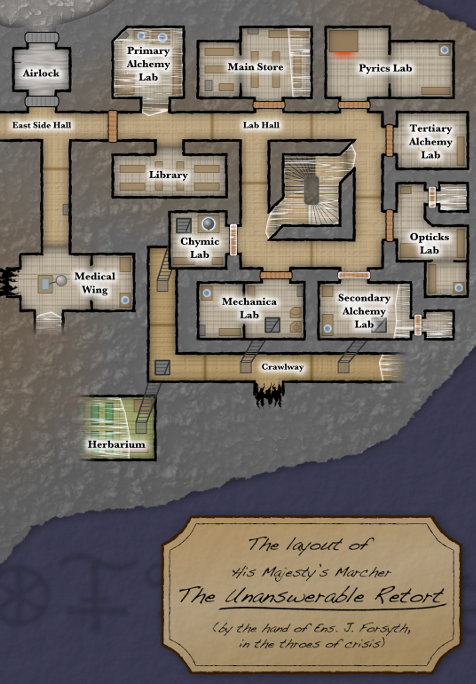 Our obvious next goal is to get through that locked fire door, but that is far from the only thing that we can attempt. There are several rituals we've never performed, and a number of devices and materials that we have not experimented with. ManxomeBromide fucked around with this message at 04:26 on Jul 16, 2018 |
|
|
|
My guess for Erebian is that it represents a frozen world where the materials would be liquid at normal human temperatures. So, stuff like dry ice. Maybe also allowing for seas composed of things that would be gaseous on Earth, like liquid methane. Meanwhile, Hadean lands are just dead rock. I appreciate that, despite being in considerable duress and lacking any kind of survival gear (we haven't seen anything I would be willing to eat* and precious little that I'd be willing to drink), Ensign Forsyth still took the time to draw an awfully detailed map. * Maybe the mushroom, but eating unknown fungi is a risky business...
|
|
|
|
TooMuchAbstraction posted:I appreciate that, despite being in considerable duress and lacking any kind of survival gear (we haven't seen anything I would be willing to eat* and precious little that I'd be willing to drink), Ensign Forsyth still took the time to draw an awfully detailed map. If this is some kind of time disruption or interrupted transition, we may need that map to prove anything happened when the crew wakes up.
|
|
|
|
Once we've actually done a ritual, the parser remembers that we know how to do it, right? I'd say then we ought to try as many recipes as we can make, since the option to RESTART allows us to reset things if it turns out we used up something we shouldn't have. That way in the future if we want to go through the rituals again we won't have to do it step by step anymore.
|
|
|
|
TooMuchAbstraction posted:* Maybe the mushroom, but eating unknown fungi is a risky business... What's the worst that can happen?
|
|
|
|
Nakar posted:Once we've actually done a ritual, the parser remembers that we know how to do it, right? I'd say then we ought to try as many recipes as we can make, since the option to RESTART allows us to reset things if it turns out we used up something we shouldn't have. That way in the future if we want to go through the rituals again we won't have to do it step by step anymore. Simply cleaning out our present repertoire of rituals, verbs, and item interactions produced an update twice the size of what I've generally been aiming for, so, uh, bonus increased update speed this weekend, I guess! macdjord posted:> EAT MUSHROOM If you're playing casually, Hadean Lands is Merciful on the Zarfian Cruelty Scale. (And yes, same Zarf. I did say he was an important figure in IF theory and technology.) The worst you can do is create a condition where you have to >RESET sooner than you'd like. As we'll see next update, >RESET ends up altering its meaning over time as you hit various milestones, so as an LPer the worst that can happen is that I can lock myself out of a phenomenon I want to show off before I can in fact show it off. I'm working in part off of notes, cheatsheets, and walkthroughs to prevent myself from doing this by accident.
|
|
|
|
Part 5: System Mastery Trap Once we get through that fire door, the game's possibility space is going to explode. We'll be spending several updates simply exploring obvious exits and cataloguing new things we can do. There is a real danger that important and extremely basic capabilities may be lost in the flood. So, before we dive into that enormous sea, we'll be putting our little corner in order and doing all the things we know how to do. In the process, I will also introduce the last of Hadean Lands's unique helper verbs. As it stands, there is one locked door we haven't opened (the fire door), one device we haven't experimented with (the wire-wheel), and three rituals we know but have not yet successfully performed (creating a fire resistance potion, creating a resonant oculus, and the redoubled brass tarnish removal ritual). There's a key that is associated with fire drills roasting in the kiln. That's our best bet for opening that door. The direct approach would be to make ourselves fire-resistant and then pull the key out of the kiln with our bare hands. Now, how did that ritual go? We can look it up in the alchemy journal, but we can also >RECALL rituals and facts: quote:>RECALL FIRE RESISTANCE I wonder if Lt. Anderes is senior enough that they let her poison people. We can also recall things we've seen: quote:>RECALL ANDERES We can try to recall things that we haven't seen yet, but that doesn't work as well: quote:>RECALL CAPTAIN And recalling items that no longer exist works as well as it can: quote:>RECALL PINE CONE We need that pine cone to do the redoubled tarnish cleansing ritual, but that can wait. We have everything we need to do the other two rituals, so let's handle those first. I'd happened to pick up all the components we'd needed along the way, but apparently I was overly neat and tidy when I made the fungicide because I don't have the saline. I could walk back through the Mechanica Lab and the crawlspaces to get to the Chymic lab, but we don't need to do that. quote:>GO TO SALINE Oh, also I carelessly left that door open. Let's fix that. We don't want some toxic alien ocean flooding the Chymic Lab if that fracture becomes porous. quote:>CLOSE DOOR "Thalassa," in passing, is the old Greek word for seas generally and the primordial goddess thereof. Hadean Lands invoke Hades, the Greek God of the underworld, and Erebian Lands invoke Erebus, the primordial darkness and possibly the vestibule of the underworld, depending on exactly what myth you're reading. Now that we have the saline, we can brew a fire resistance potion. There was an alchemical bound in the Pyrics Store. That's right next to that key, so that's as good a place as any to do the ritual. >GO TO works on rooms as well as objects. Let's get to work. quote:>GET SALINE Wait a minute. Orange? That's the color of a fiery atmosphere. I double-check our inventory and the ginger impet is closed. We need there to be no contaminating influences at the start. It seems, however, that operating a ritual inside an active kiln adds a fiery atmosphere no matter what. We'll have to go back to our first workbench for this one. Fortunately, that's only one command away. Motion commands will even do cleanup operations for us: quote:>GO TO SECONDARY ALCHEMY LAB Hrm. That pin has got to go. quote:>GET PIN To work. quote:>PUT SALINE IN BOUND Simple enough. We've also learned two more things about ritual bounds: a "pale" glow means no atmosphere is present, and the color of the glow does not change once the seal is made, even if the atmosphere changes. Now let's get that key. We could explicitly go to the Pyrics lab, but the game also remembers the last room we entered a command in: quote:>GO BACK Handy. That's not quite where we need to be, though. quote:>WEST Did we really need to brew this potion? quote:>GET KEY Yes. Let's do that, and see what this porcelain paten is, too. quote:>DRINK FIRE RESISTANCE Mission accomplished! Let's go confirm it unlocks the fire door. quote:>SOUTH The Nave leads us to the rest of the game, more or less, so we'll leave that alone. Let's check out this Airlock and Medical Wing, though, to finish our exploration of the East Wing. quote:>NORTH Let's... maybe not mess with this yet. This does, however, give us some notion of what it is a marcher does. The doors in a marcher seem to be able to be set up to go somewhere else. But it doesn't seem to actually travel, per se: instead it arranges itself so that it is "rigged into" other worlds. We also here see the name for worlds that aren't terrifying hellholes deadly to all Earthly life: they are Gaian lands. The Empire's world naming nomenclature is consistently Greek. That's about it for the airlock. Let's look into the Medical Wing, to the south. quote:Medical Wing Hallway Man, that must be pretty awful to squick out an alchemist. Let's check that door to the south. quote:>SOUTH Apparently the Medical Wing is haunted. A less scientific age would consider it a soul-sucking, malevolent spirit—fortunately, in these enlightened times we know that it is instead a inanimate but self-perpetuating soul-sucking phenomenon. Science, ladies and gentlemen. This knowledge improves our ability to act with wisdom and foresight. That's all we can do in the East Wing beyond the fire door for now. Let's go check out the wire wheel and do the last two rituals. quote:The wire-splicer—affectionately known to the apprentice crew as the Rumpelstiltskin wheel—sports a pair of tiny holes beneath a fearsome array of reels and gears. You feed in two lengths of metal wire, and it folds them together—then folds them again and again, until the metals have blended into a uniform alloy. (Turning the wheel is a tedious chore, but it's easier than messing around with furnaces and crucibles.) To use this we need wires, and to get wires we need metal rods. We used the platinum rod to make a catalytic environment for the universal solvent, but we've seen other rods around and about. We can use the command >THINGS to recall every portable item we've ever seen or created: quote:>THINGS Holy poo poo. The platinum's already a wire, so we can extract that from the adjustable bound in the Materials Store: quote:>GET PLATINUM The Moon-Metal rod was here too. What the Hell is moon-metal, anyway? quote:>EXAMINE MOON-METAL I'd suggest "selenium" as the obvious lazy choice, but selenium is not a metal. Palladium fits the description but it's hardly the only element that does. The nickel rod was with the platinum one in the Mechanica Lab, and the lead rod was in the Pyrics Store. These are all easily turned into wire, and there's a lovely extra detail when we try to draw nickel into wire: quote:You begin hauling on the crank, and the nickel rod is slowly drawn into the device. It's terrible work—nickel isn't a soft metal—but you throw your weight on it, and soon wire begins spooling out onto the counter. Okay. Time to make some alloys. quote:>PUT PLATINUM IN SPLICER ... well, that didn't end well. We could >RESTART, but since we're going to be destructively altering the wire in a systematic way, it's much more convenient to use out-of-game resetting actions: quote:>UNDO Hm. Maybe moon-metal is iridium, if it alloys with platinum into a "royal" metal. But iridium isn't a little heavier than silver; assuming rods of uniform size it would be twice as heavy as lead. All other combinations—including combinations using electrum regium wire—fail the same way platinum and nickel did. There is, however, one other fun thing we can do with the splicer, which is to only feed it one wire instead of two: quote:>TURN WHEEL There's one last thing to do here, though. Remember the locked cabinet in the Materials Store? Neither did I. The >DOORS command is here to remind me of it: quote:>DOORS Hang on, we have one of those. quote:>UNLOCK CABINET WITH ALCHEMY FILE SEAL We've been talking about phlogiston as if it is simply the absence of oxygen, much like how we talk about electrical currents as if it were the positive charges flowing. That only works to a point. Once you start phlogisticating beyond the level of "no oxidation," you are apparently back in Wacky Alchemical Magic land. This metal is now so metal that it's more metal than metal.  If we try to draw it into wire, though... quote:You notice sparks flying from between the rollers, however, and the wire emerges without the luster you expect. Apparently you're pressing the phlogiston right out of the metal. That's a disappointment. It is, but we do at least get some gold wire for our troubles. That will alloy with nickel to produce "ring-gold." quote:>EXAMINE RING-GOLD We can't undo the creation of electrum regium—at least, not without the AI also forgetting how we made it—so we'll need to do a >RESTART to test those cases. Fortunately, we need to >RESTART anyway to get our pinecone back so we can execute the redoubled tarnish cleansing ritual. Lets go clean the everliving poo poo out of those calipers. quote:>RESTART Er, right. We'll need to do a >RESET. quote:>RESET That was polite of the game. As we advance through the game, the earliest parts of the gameplay cycle will be done as part of the reset. When we unlocked the fire door, unrusting the first door becomes automatic. We collect the items we need, and... quote:>PUT PIN IN BOUND One down, one to go. We'll want to go to the Opticks Lab to create our resonant oculus, so let's do that. quote:>GO TO OPTICKS ANNEX The AI politely informs us that we are idiots. We'll have to >RESET again. After that, let's see how long a chain of operations we can force at once: quote:>GO TO AIRLOCK Not bad. Not optimal—we travel to the Pyrics Lab before remembering that we need to brew a fire resistance potion—but the job is done. As long as I'm doing a bunch of resets, I test alloying gold wire with platinum and moon-metal. Both work, producing "whitgold" and "moongold" respectively. Each is described simply as "a white alloy of gold and platinum/moon-metal." Also, the goal-seeking applies to more than ritual products: >CREATE GOLD WIRE went and picked up the Alchemy File Seal, unlocked the cabinet, and operated the wire-drawer for me. Oh, and, as long as we're experimenting: quote:>EAT MUSHROOM That about wraps it up for the Mechanica Lab. Our remaining ritual is the creation of a resonant oculus. We'll need a glass loop (there's one in the Mechanica Lab), a bound with a gestalt shelf with no contaminating influences (there's one in the Opticks Annex), and a lunar influence to put on the gestalt shelf (the rotor card from the Library had a "moonlit night" option). quote:Opticks Annex Okay. How about the silver and brass coins I coincidentally picked up from the Pyrics Store and Chymic Lab while gathering materials? quote:>LOOK AT SILVER COIN THROUGH OCULUS That's an insistent little addendum. Let's follow through. quote:>LOOK AT SPARK Welcome to the single most obnoxious mechanic in Hadean Lands. If you don't twig to the fact that the "spark" is something you need to check out explicitly, you will end up missing a large number of facts you need to proceed. The sparks layer an entire new map of clues onto the normal map, and we will need to >LOOK THROUGH OCULUS in every room to check it for sparks. This is extra aggravating because the more familiar you are with text games, the less likely you are to think looking at nothing in particular is helpful, and the more likely you will brickwall on this.  But it turns out that there's a lot of game left to go before we notice this actually cramping our style. But it turns out that there's a lot of game left to go before we notice this actually cramping our style.In the interests of simulating this effect, and also to space out the firehose of options the game is going to be giving us, I intend to delay the harvest of sparks as long as possible. That's no reason to not try this one out, though. There was a silver chain in the materials store and that should serve us well as a "silver thread". We've already got a lunar environment, and we can use the ginger impet to contaminate the environment. quote:>OPEN GINGER Hm. That won't work. "Pale" means "No environment." We want a silver glow, like we had with the oculus itself. We're stymied in this attempt, but we have a terrifying number of resources available to us even with no further exploration. We should be able to make this work. Next Time: The Retort is now, mostly, open to us. We will be able to spend some time absorbing new locations and facts and making note of new barriers. That's basically what the last update was, while this update was dedicated to systematically exercising the knowledge we had collected. So, there are two things to give simple votes on:
ManxomeBromide fucked around with this message at 04:35 on Jul 16, 2018 |
|
|
|
And now we've finally seen both how complicated this game can get (but not the most extreme examples by any means) and how incredibly the game bends over backwards to provide every conceivable resource to help you with that complexity. It's amazing.
|
|
|
|
Put the silver coin on the shelf as well.
|
|
|
|
Or if that's not enough moon, perhaps we could look at the moon metal through the oculus too see if it also has a lunar nature?
|
|
|
|

|
| # ? May 5, 2024 00:47 |
|
Zack Ater posted:Or if that's not enough moon, perhaps we could look at the moon metal through the oculus too see if it also has a lunar nature? That would be my vote. Using a moon metal wire loop in the ritual, or just having the moon metal on the gestalt shelf, seems likely to give us a stronger lunar ambiance. A bit of a long shot, but it might also be worth investigating how convex/concave lenses interact with rituals. Can we focus environmental effects to concentrate them?
|
|
|


